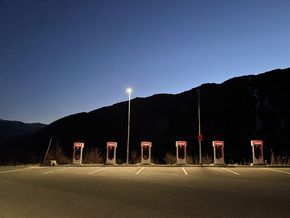If you fill up a fossil car with fuel, you will find yourself at a petrol station that has all the facilities that it entails. However, if you stop charging the electric vehicle, you may run the risk of ending up in a secluded parking lot off the beaten track. If there’s a store in the area, it’s usually too far away to be able to bear to go there while the car is charging. Frustration builds among the passengers faster than the car absorbs electricity. Why not put more fast chargers where you can go to the toilet or buy a coffee?
With the exponential increase in the number of electric vehicles, it is important that the development of charging stations continues to keep pace. In the National Tariff Strategy published by the Ministry of Transport and Communications in December 2022, a target was set to achieve a significant increase of approx. 5,000 fast chargers today to between 10,000 and 14,000 fast chargers in 2030.
The question is where the new charging stations will be built. PricewaterhouseCoopers has developed a forecasting model for charging stations that takes into account a number of different parameters.
– We’ve trained a machine learning algorithm to understand what defines a good site, explains Daniel Kinn at PwC Deal Analytics.
Then it’s a matter of starting from existing freight networks and looking at everything from distances and traffic conditions to nearby tourist attractions.
Keene says demographics, electric vehicle density, type of traffic spread over different days, nearest city, and location relative to shopping centers are among the weighted variables.
More accurate ratings
Transaction Analytics is a division at PricewaterhouseCoopers that works with data analysis within transaction advice. Geographic insight, predictive analysis, and pattern recognition are keywords for their working methods.
Understanding the company to be bought or sold often requires knowing customer data and their locations. How attractive is it and what is the potential for expansion? Our forecast model for charging station rollouts is a great way to show the expertise we use when we analyze companies on a daily basis, explains Ola Thune Øritsland at PwC Deal Analytics.

Today there are about 560,000 electric cars in Norway, and the number is growing. At the same time, we’re seeing the range and speed of new car shipments increase from year to year. How many fast chargers will we actually need?
– Although many people charge at home or at work, outside of the daily driving pattern, there is often a desire to be able to charge in connection with shopping, attractions, or trips to the cabin.
He says occupancy at the existing charging stations was an indication of what a good location it was. When data was available, the model also included it in the calculations.
– We have entered a sample on which we are training the model. Population within 5 km and year-round traffic are among the most important variables in the big picture.
Do you work with technology at PricewaterhouseCoopers? »
The prediction model classifies the potential for a particular site as either high, medium, or low. The assessments made become increasingly accurate as the model is trained and fed data.
Part of the toolbox
There are two ways to use the form. Either he can estimate the success rate of specific plans for charging stations, or he can suggest points on the road network where it is best to place new charging stations.
PricewaterhouseCoopers developed the model on their own initiative – as a concrete tool and to show how they attack such issues.
– This method of working is part of our toolbox, whether we use it in charging stations, grocery stores, or other industries.

Website analytics is relevant in many contexts. In 2020 PwC undertook a project with the Ministry of Finance where machine learning and geo-analytics were used to rate all holiday homes in Norway. The technology and approach are similar to what was being done at the time.
– The difference is that the calculations are faster now. Data is more readily available. And then there’s the evolution of machine learning and model tuning that’s been absolutely amazing. Thus, three people managed to do this project in three to four months, in parallel with other tasks.
Greater need near major cities
– The data collected came from various sources, such as Statistics Norway on demographics, SVV on route data, and many different sources on points of interest in the local area. Getting and processing everything has been an evolutionary task.
Without going into detail about the results, Kinn and Øritsland point to a greater need for fast chargers near major cities.
– In Oslo, there are quite a few people who live in apartments and don’t necessarily have access to a fee attached to the house. This is an important factor to take into consideration.

The forecasting model for charging stations is an ongoing project that PwC is developing further and is using it through strategic consulting and dealings with its clients.
Deal Analytics and Deals Strategy in Norway, as well as colleagues at Strategy&, PwC’s global strategic advisory unit, work closely with leading freight operators. Securing good sites early on with good power access and attractive site parameters is a major issue for freight operators; Proper use of chargers is very important to the profitability of businesses.
North Summit EV
This was high on the agenda at the Nordic EV Summit industry conference in Lillestrøm 4-5. May, as PwC and Strategy & were the main sponsors and most of the market players were present.
PwC Director Milos Bartosek gave a presentation on the feasibility and profitability of public fast chargers.

– The usage rate is on the rise and the average today is 6-7 charging sessions per day. That’s enough for the stations to be profitable, but the difference is huge. Norway leads in other markets, particularly chargers for urban destinations and quick chargers at gas stations along busy roads, which are showing repeat use and very good profitability, Bartosek says.
On the occasion of the EV Nordic Summit, PwC and Strategy & have also published a new global market report on the electric vehicle charging sector, the EV Charging Market Outlook. The report focuses on growth in the market, different players, as well as strategic assessments for profitable growth.
Check out your opportunities at PricewaterhouseCoopers within Technology »

“Web specialist. Lifelong zombie maven. Coffee ninja. Hipster-friendly analyst.”




